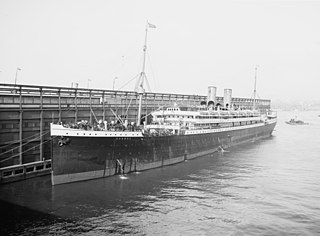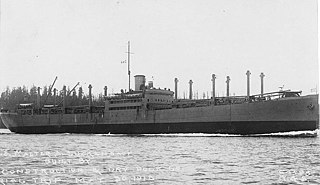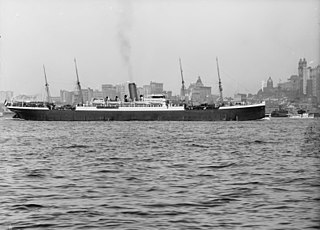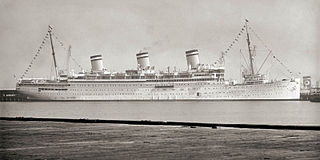
USS Nicholson was an O'Brien-class destroyer built for the United States Navy before the American entry into World War I. The ship was the second U.S. Navy vessel named in honor of five members of the Nicholson family who rendered distinguished service in the American Revolutionary War, the War of 1812, and the American Civil War: brothers James, Samuel, and John Nicholson; William Nicholson, son of John; and James W. Nicholson, grandson of Samuel.

USS Freedom (ID-3024) was a cargo and transport ship in the United States Navy in World War I. Originally Wittekind for the North German Lloyd line, the ship also served as USAT Iroquois and USAT Freedom after being seized by the United States in 1917.

The Hamburg-Amerikanische Packetfahrt-Actien-Gesellschaft (HAPAG), known in English as the Hamburg America Line, was a transatlantic shipping enterprise established in Hamburg, in 1847. Among those involved in its development were prominent citizens such as Albert Ballin, Adolph Godeffroy, Ferdinand Laeisz, Carl Woermann, August Bolten, and others, and its main financial backers were Berenberg Bank and H. J. Merck & Co. It soon developed into the largest German, and at times the world's largest, shipping company, serving the market created by German immigration to the United States and later, immigration from Eastern Europe. On 1 September 1970, after 123 years of independent existence, HAPAG merged with the Bremen-based North German Lloyd to form Hapag-Lloyd AG.

USS Pocahontas (SP-3044) was a transport ship for the United States Navy during World War I. She was originally SS Prinzess Irene, a Barbarossa-class ocean liner built in 1899 by AG Vulcan Stettin of Stettin, Germany, for the North German Lloyd line.
Norddeutscher Lloyd was a German shipping company. It was founded by Hermann Henrich Meier and Eduard Crüsemann in Bremen on 20 February 1857. It developed into one of the most important German shipping companies of the late 19th and early 20th centuries, and was instrumental in the economic development of Bremen and Bremerhaven. On 1 September 1970, the company merged with Hamburg America Line (HAPAG) to form Hapag-Lloyd AG.

Kronprinz Wilhelm was a German ocean liner built for Norddeutscher Lloyd, a shipping company now part of Hapag-Lloyd, by the AG Vulcan shipyard in Stettin, Germany, in 1901. She was named after Crown Prince Wilhelm, son of the German Emperor Wilhelm II, and was a sister ship of SS Kaiser Wilhelm der Grosse.

SS Kronprinzessin Cecilie was an ocean liner built in Stettin, Germany in 1906 for North German Lloyd that had the largest steam reciprocating machinery ever fitted in a ship. The last of four ships of the Kaiser class, she was also the last German ship to have been built with four funnels. She was engaged in transatlantic service between her home port of Bremen and New York until the outbreak of World War I.

The SS Bremen, later renamed Constantinople and then King Alexander, was a German Barbarossa class ocean liner commissioned in 1897 by Norddeutscher Lloyd.

USS Bridgeport (AD-10/ID-3009) was a destroyer tender in the United States Navy during World War I and the years after. She was a twin-screw, steel-hulled passenger and cargo steamship built in 1901 at Vegesack, Germany as SS Breslau of the North German Lloyd line. Breslau was one of the seven ships of the Köln class of ships built for the Bremen to Baltimore and Galveston route.

USS Aeolus (ID-3005), sometimes also spelled Æolus, was a United States Navy troopship in World War I. She was formerly the North German Lloyd liner Grosser Kurfürst, also spelled Großer Kurfürst, launched in 1899 that sailed regularly between Bremen and New York. At the outset of World War I the ship was interned by the United States and, when the US entered the war in 1917, was seized and converted to a troop transport.

SS Friedrich der Grosse was a Norddeutscher Lloyd liner built in 1896 which sailed Atlantic routes from Germany and sometimes Italy to the United States and on the post run to Australia. At the outset of World War I the ship was interned by the U.S. and, when that country entered the conflict in 1917, was seized and converted to a troop transport, becoming USS Huron (ID-1408).

The Barbarossa class was a class of ocean liners of North German Lloyd and the Hamburg America Line of the German Empire. Of the ten ships built between 1896 and 1902, six were built by AG Vulcan Stettin, three were built by Blohm & Voss, and one was built by Schichau-Werke; all were built in Germany. They averaged 11,000 gross register tons (GRT) and featured twin screw propellers driven by quadruple-expansion steam engines.

USS Walter A. Luckenbach (ID-3171) was a United States Navy cargo ship and troop transport in commission from 1918 to 1919.

SS Uhenfels was a German-built heavy-lift ship that was launched in 1931 for DDG Hansa. She was captured by the Royal Navy in 1939, two months after the start of the Second World War. The UK Ministry of Shipping renamed her Empire Ability and contracted Elder Dempster Lines to operate her. In 1941 a German U-boat sank her by torpedo.

The 1900 Hoboken Docks fire occurred on June 30, 1900, and killed at least 326 people in and around the Hoboken, New Jersey, piers of the Norddeutscher Lloyd (NDL) shipping company. The piers were in New York Harbor, at the foot of 3rd and 4th Streets in Hoboken, across the North River from Manhattan in New York City. The area, a few blocks north of Hoboken Terminal, is now mostly part of the Hudson River, without docks: a waterfront bicycle path lines it.

The Rivers class was a class of eleven ocean liners of the Norddeutscher Lloyd (NDL), the first class of German express liners. The ships were built between 1881 and 1890, the first nine in Glasgow by John Elder & Co. or the renamed Fairfield Shipbuilding and Engineering Company, the last two in Stettin by Vulcan. All were named for rivers in Germany.

SS Main was an ocean liner of the Rhein class of North German Lloyd. She was in service on the route from Bremen to Baltimore from her 1900 launch until seized by the Allies of World War I in 1914, and was involved in the 1900 Hoboken Docks Fire. Unlike her sister ships Neckar and Rhein, she never entered service for the United States Navy.

The SS Harry Luckenbach, built as a cargo ship ordered by the Luckenbach Steamship Company and built at Sun Shipbuilding and Drydock Co. in Chester, Pennsylvania in 1919. The as yet unnamed ship was requisitioned by the United States Shipping Board (USSB) before completion and converted to a troop transport. The USSB allocated the ship, which had been fitted out with temporary troop accommodation in its cargo spaces, to the Navy which commissioned the ship on 7 July 1919 as USS Sol Navis with the Identification number 4031A. The ship was decommissioned October 1919 after two trips to France.

SS Reliance was one of a pair of transatlantic steam ocean liners that were launched in 1914 in Germany for the Hamburg America Line (HAPAG), sold to a Dutch shipping line in 1916, and seized by the United States as World War I reparations in 1922. United American Lines (UAL) operated her until 1926, when HAPAG bought her back.

SS Willehad was a passenger and cargo steamship that was built in Germany in 1894 for Norddeutscher Lloyd (NDL). For her first few years she took emigrants from Bremen to the United States. In 1900 she made one round trip between Bremen and Australia via the Suez Canal. Between 1901 and 1903 her route was between Bremen and South America. For a few months in 1904 she sailed between Stettin in Germany and New York. From the end of 1904 to the beginning of 1907 she was a mail ship between Japan and Australia. From 1911 until 1914 she ran transatlantic services between Hamburg and the United States, and also between Hamburg and Canada.



















